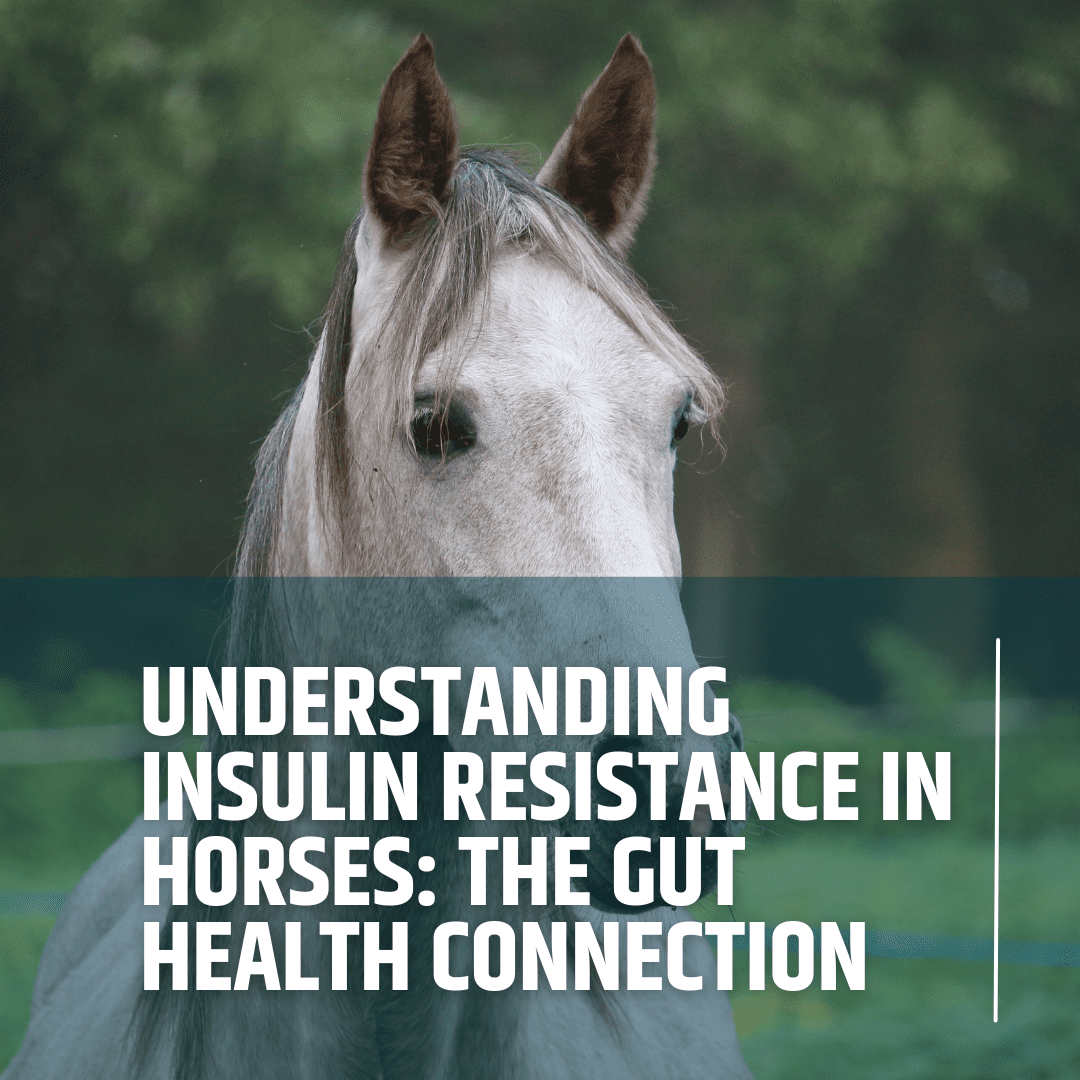
01
Introduction
In recent years, the equine veterinary community has increasingly recognised the intricate relationship between insulin resistance (IR) and gut health in horses. This complex interaction plays a crucial role in both the development and management of metabolic disorders, making it essential for horse owners and professionals to understand the connection.
02
Understanding Insulin Resistance in Horses
Insulin resistance occurs when the body's cells become less sensitive to insulin, the hormone responsible for regulating blood glucose levels. In horses, this condition often manifests as part of Equine Metabolic Syndrome (EMS) and can lead to serious health complications, including laminitis (1). While genetics and obesity are well-known risk factors, emerging research suggests that gut health plays a more significant role than previously understood.
03
The Gut-Insulin Connection
The equine digestive system is remarkably complex, and its health status directly influences metabolic function. Recent studies have shown that disturbances in the gut microbiome can contribute to altered glucose metabolism, increased inflammation, compromised nutrient absorption, and modified hormone production and regulation (2). These factors can either trigger or exacerbate insulin resistance, creating a challenging cycle for affected horses.
04
The Role of Gut Microbiome
The horse's hindgut houses billions of beneficial bacteria that are fundamental to overall health. These microorganisms serve multiple essential functions within the digestive system. They are responsible for digesting complex carbohydrates, producing vital nutrients, supporting immune function, and maintaining gut barrier integrity. When this delicate ecosystem becomes imbalanced, it can trigger several adverse effects throughout the body. These include widespread inflammation, altered energy metabolism, compromised nutrient absorption, and significant changes in hormone production and sensitivity. According to a recent study published in the World Journal of Diabetes (3), the gut microbiome has been identified as a key factor leading to insulin resistance.
05
Impact of Diet on Gut Health and Insulin Sensitivity
The modern equine diet often includes concentrated feeds and rich pastures that can challenge both gut health and insulin sensitivity. High-starch diets can overwhelm the small intestine's digestive capacity, allowing undigested starch to reach the hindgut (6). According to Colombino et al. (2022), this not only disrupts the microbial balance but also creates an inflammatory environment that can exacerbate insulin resistance (6).
06
Managing Insulin Resistance Through Gut Health
Dietary Management
The cornerstone of managing insulin resistance lies in supporting a healthy gut microbiome through appropriate nutrition. First and foremost, it's essential to limit non-structural carbohydrates by restricting access to rich pastures, choosing low-sugar and low-starch feeds, and carefully monitoring total daily NSC intake. High-quality forage should be the foundation of the diet, with careful selection of appropriate hay types. Some owners may need to consider soaking hay to reduce sugar content, and implementing slow-feeding systems can help regulate intake. Establishing appropriate feeding schedules is equally important - maintaining regular feeding times, allowing for natural grazing patterns, and avoiding long periods without forage can all contribute to better metabolic health.
Exercise and Weight Management
Physical activity plays a crucial role in both metabolic and gut health. Regular exercise has been shown to improve insulin sensitivity while supporting healthy gut motility. Additionally, consistent activity helps maintain appropriate body condition, which is essential for managing insulin resistance effectively.
07
Supporting Gut Health
Several strategies can help maintain optimal hindgut function. The promotion of beneficial bacteria is crucial and can be achieved through consistent forage availability and stable feeding routines. Some horses may benefit from additional digestive support, when deemed appropriate by a veterinarian. It's essential to minimise gut disruption by avoiding sudden feed changes, managing stress levels, and maintaining regular deworming schedules. Horse owners should also closely monitor gut health indicators by observing manure consistency, watching for signs of digestive discomfort, and tracking changes in appetite and water intake.
08
Monitoring Success
Success in managing insulin resistance through gut health support can be observed through various indicators. Owners often notice improved body condition and more consistent energy levels in their horses. The quality of droppings typically improves, and signs of digestive discomfort tend to decrease. Many horses also show enhanced coat condition, and regular veterinary checks often reveal more stable blood glucose levels.
09
Conclusion
Understanding the connection between insulin resistance and gut health opens new avenues for managing metabolic conditions in horses. The key lies in recognising that metabolic health isn't just about controlling sugar and starch intake – it's about nurturing a healthy digestive system that can properly process nutrients and maintain hormonal balance.
Success in managing insulin-resistant horses requires a comprehensive approach that prioritises appropriate dietary management, regular exercise, stress reduction, consistent monitoring, and professional veterinary guidance. Remember to consult with your veterinarian when developing a management plan for insulin-resistant horses, as each case requires individual consideration and monitoring. With proper attention to gut health and metabolic function, many horses with insulin resistance can maintain active, healthy lives while minimising the risk of associated complications.
References
1. The British Horse Society. (2023, October 2). Equine Metabolic Syndrome
Equine Metabolic Syndrome (EMS) is a hormonal disorder similar to type 2 diabetes in humans. https://www.bhs.org.uk/horse-care-and-welfare/health-care-management/horse-health/equine-diseases/equine-metabolic-syndrome/
2. Chaucheyras-Durand, F., Sacy, A., Karges, K., & Apper, E. (2022). Gastro-Intestinal Microbiota in Equines and Its Role in Health and Disease: The Black Box Opens. Microorganisms, 10(12), 2517. https://doi.org/10.3390/microorganisms10122517
3. Jang, H. R., & Lee, H. Y. (2021). Mechanisms linking gut microbial metabolites to insulin resistance. World journal of diabetes, 12(6), 730–744. https://doi.org/10.4239/wjd.v12.i6.730
4. McGowan, C. M., Dugdale, A. H., Pinchbeck, G. L., & Argo, C. M. (2013). Dietary restriction in combination with a nutraceutical supplement for the management of equine metabolic syndrome in horses. Veterinary journal (London, England : 1997), 196(2), 153–159. https://doi.org/10.1016/j.tvjl.2012.10.007
5. Rankovic, A. (2024, April 29). How to Feed a Horse with Equine Metabolic Syndrome. MB Mad Barn. https://madbarn.com/how-to-feed-metabolic-horse/
6. Colombino, E., Raspa, F., Perotti, M., Bergero, D., Vervuert, I., Valle, E., & Capucchio, M. T. (2022). Gut health of horses: effects of high fibre vs high starch diet on histological and morphometrical parameters. BMC veterinary research, 18(1), 338. https://doi.org/10.1186/s12917-022-03433-y
ABOUT EQUINECTAR
Description
EquiNectar® is a natural feed supplement, that is scientifically proven to:
- Re-balance your horse’s gut bacteria
- Help your horse maximise benefits from its feed
- Improve your horse’s condition
More information
EquiNectar® is produced by Tharos Ltd in the UK. It is a natural source of digestive enzymes and contains only the following ingredients:
- Our patented enzyme rich malt extract
- Medium chain triglycerides (from coconut oil)
- Potassium sorbate
For more details of the enzymes within EquiNectar® take a look at the ingredients and enzymes page.
How to feed
Simply add EquiNectar® to your horse's daily feed, using the Feeding Rate chart to determine the correct amount.
For detailed instructions about how to introduce EquiNectar, please read the comprehensive Feeding Guide page.





